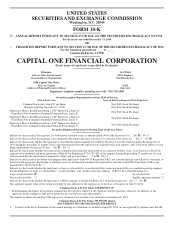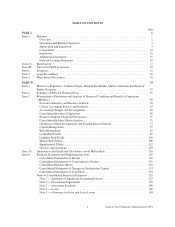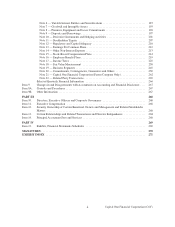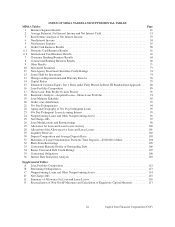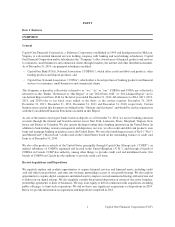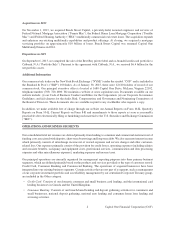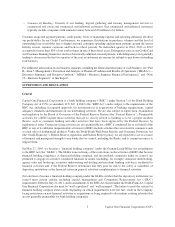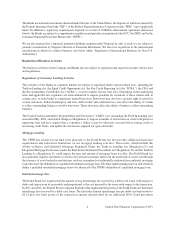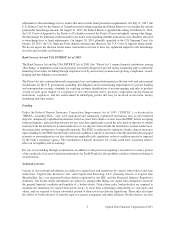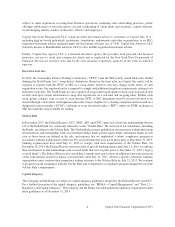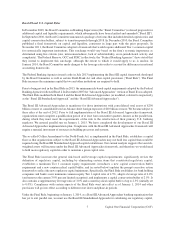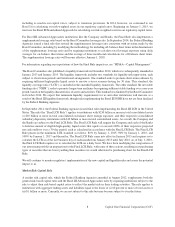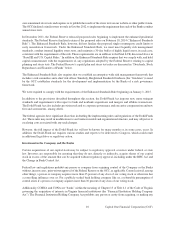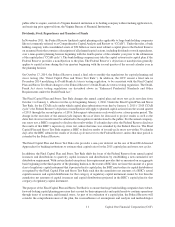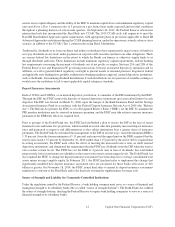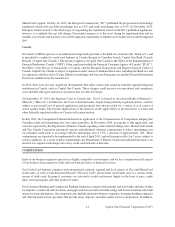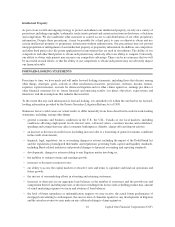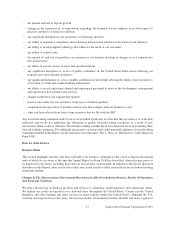Capital One 2014 Annual Report Download - page 29
Download and view the complete annual report
Please find page 29 of the 2014 Capital One annual report below. You can navigate through the pages in the report by either clicking on the pages listed below, or by using the keyword search tool below to find specific information within the annual report.Basel III and U.S. Capital Rules
In December 2009, the Basel Committee on Banking Supervision (the “Basel Committee”) released proposals for
additional capital and liquidity requirements, which subsequently have been clarified and amended (“Basel III”).
In September 2010, the Basel Committee announced a package of reforms that included detailed capital ratios and
capital conservation buffers, subject to transition periods through 2018. In December 2010, the Basel Committee
published a final framework on capital and liquidity, consistent in large part with the prior proposals. In
November 2011, the Basel Committee adopted a framework that would require additional Tier 1 common capital
for systemically important institutions. This surcharge would vary based on the firm’s systemic importance as
determined using five criteria (size, interconnectedness, lack of substitutability, cross-jurisdictional activity and
complexity). The Federal Reserve, OCC and FDIC (collectively, the “Federal Banking Agencies”) have stated that
they intend to implement this surcharge, although the extent to which it would apply to us is unclear. In
January 2014, the Basel Committee made changes to the leverage ratio rules to account for differences in national
accounting frameworks.
The Federal Banking Agencies issued a rule in July 2013 implementing the Basel III capital framework developed
by the Basel Committee as well as certain Dodd-Frank Act and other capital provisions (“Final Rule”). The Final
Rule increases the minimum capital that we and other institutions are required to hold.
Prior to being revised in the Final Rule in 2013, the minimum risk-based capital requirements adopted by the Federal
Banking Agencies followed Basel I. In December 2007 the “Advanced Approaches” version of Basel II was adopted.
The Final Rule modified both Basel I and the Basel II Advanced Approaches (as modified, referred to respectively
as the “Basel III Standardized Approach” and the “Basel III Advanced Approaches”).
The Basel III Advanced Approaches is mandatory for those institutions with consolidated total assets of $250
billion or more or consolidated total on-balance-sheet foreign exposure of $10 billion or more. We became subject to
these rules at the end of 2012. Prior to full implementation of the Basel III Advanced Approaches framework,
organizations must complete a qualification period of at least four consecutive quarters, known as the parallel run,
during which they must meet the requirements of the rule to the satisfaction of their primary U.S. banking
regulator. We entered parallel run on January 1, 2015. We have completed the development of our Basel III
Advanced Approaches implementation plan. Compliance with the Basel III Advanced Approaches framework will
require a material investment of resources in building processes and systems.
The so-called Collins Amendment to the Dodd-Frank Act, as implemented in the Final Rule, establishes a capital
floor so that organizations subject to the Basel III Advanced Approaches may not hold less capital than would be
required using the Basel III Standardized Approach capital calculations. Our current analysis suggests that our risk-
weighted assets will increase under the Basel III Advanced Approaches framework, and therefore we would need
to hold more regulatory capital in order to maintain a given capital ratio.
The Final Rule increases the general risk-based and leverage capital requirements; significantly revises the
definition of regulatory capital, including by eliminating certain items that constituted regulatory capital;
establishes a minimum Tier 1 common equity requirement; introduces a new capital conservation buffer
requirement and a new countercyclical capital buffer; and (as noted below) updates the prompt corrective action
framework to reflect the new regulatory capital minimums. Specifically, the Final Rule establishes for bank holding
companies and banks a new minimum common equity Tier 1 capital ratio of 4.5%, adopts a leverage ratio of 4.0%
(and removes the current 3.0% percent limited exception), and implements a capital conservation buffer of 2.5%. It
also contains a supplementary leverage ratio of 3.0% and a countercyclical capital buffer of up to 2.5% (initially set
to 0.0%). Compliance with certain aspects of the Final Rule went into effect as of January 1, 2014 and other
provisions will go into effect according to different start dates and phase-in periods.
Under the Final Rule, beginning on January 1, 2014, as a Basel III Advanced Approaches banking organization that
has yet to exit parallel run, we must use the Basel III Standardized Approach for calculating our regulatory capital,
7Capital One Financial Corporation (COF)


